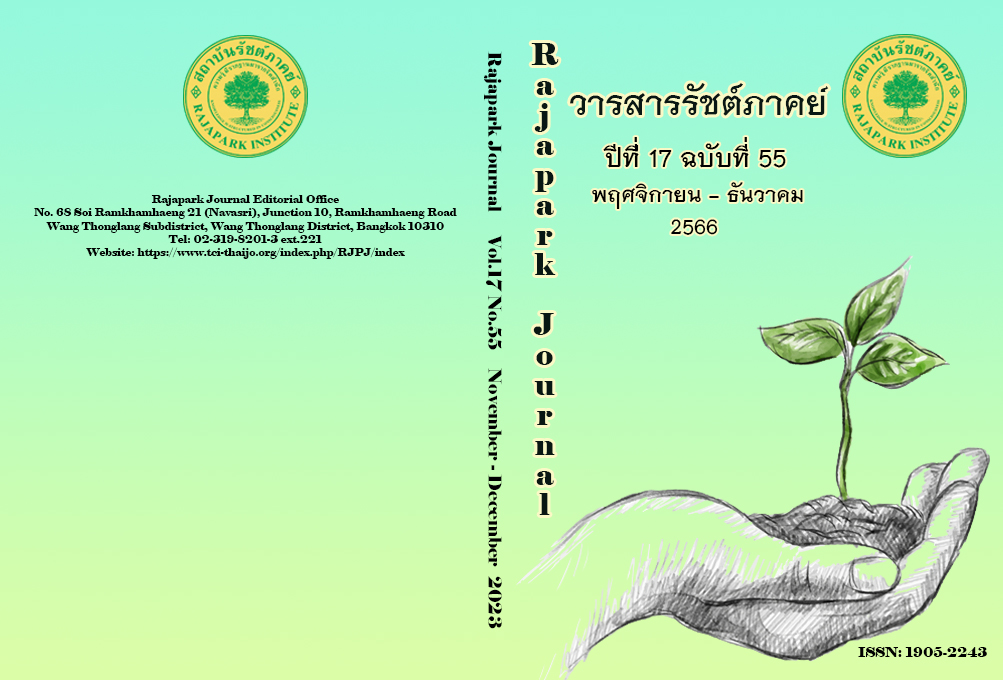Innovation for Promoting Occupation Skills to Sustainably Elevate The Grassroots Economy
Main Article Content
Abstract
Innovation is the use of knowledge or creativity in creating or changing new things that deliver benefits and values to a wider society. Innovation is like a mechanism that drives the economy and society by leaps and bounds, especially in the business and industrial sectors of the country. Therefore, it is seen as encouraging various manufacturing sectors to adopt innovations to adapt and drive economic growth widely, and it is this hope that will enable Thailand to overcome the middle income trap. In addition to the perspective of innovation in terms of economic development, sustainability can be achieved through the development of a strong social foundation. Ways to apply innovation to develop vocational skills to raise the grassroots economy sustainably include: 1) joining groups to develop learning in marketing, branding, public relations, and management by working together; 2) expanding the extension of existing community products in the area to lay an important foundation for the sustainable development of the grassroots economy; and 3) encouraging financial innovation to support funding sources for the community economy.
Article Details

This work is licensed under a Creative Commons Attribution-NonCommercial-NoDerivatives 4.0 International License.
Views and opinions appearing in the Journal it is the responsibility of the author of the article, and does not constitute the view and responsibility of the editorial team.
References
Academic Office of The Secretariat of the House of Representatives. (2015). People's participation in local government. https://dl.parliament.go.th/handle/20.500.13072/460241.
Chantaranamchoo, N., Laophuangsak, P., & Polpanthin, Y. (2018). Model of applying sufficient Economy philosophy and linkage with community economy affecting the successful of community finance institute management. Veridian E-Journal, Silpakorn University (Humanities, Social Sciences and Arts), 11(2), 3217-3232.
Hareebin, Y., Aujirapongpan, S., & Siengthai, S. (2016). The Network-Based Capability and Innovative Capabilities of Small and Medium-Sized Enterprises (SMEs). Executive Journal, 36(2), 79-88. https://so01.tci-thaijo.org/index.php/executivejournal/article/view/81357
Inthjan, B. (2017). Social Innovation Under the Royal Initiation in Pakpanang Basin, Nakhonsithammarat. Western University Research Journal of Humanities and Social Science, 2(2), 48-56.
Khomwutiwong, T. (2009). Factors Affecting Community Product Standard Certification[Independent Study of Master Degree, Chiangmai University].
Komonmarn, C. (2018). Social Innovation for Health Driving Through Child and Youth Participation. Journal of Social Work, 26(1), 120-144.
Leknoi, U. (2013). Inequality in Thai Society. Journal of Social Research Institute, 34(1), 1-12.
Loasombat, T. (2019). Social Innovation. https://social.nia.or.th/2019/article0001/
Mulgan, G., Tucker, S., Ali, R., & Sanders, B. (2007). Social Innovation: What It Is, Why It Matters and How It Can Be Accelerated. https://www.researchgate.net/publication/277873357_Social_Innovation_What_It_Is_Why_It_Matters_and_How_It_Can_Be_Accelerated.
Namburi, S. (2019). Participation Theory in Public Administration. The Journal of Research and Academics, 2(1), 183-197.
Narin, R., & Meephan, R. (2015). Community Health Care Management Innovation: ‘Ar Sa Pun Suk’ (Happiness Sharing Volunteer). Nursing Journal, 42(4), 1-11.
National Economic and Social Development Board, Council. (2018). Development Plan of National Economy and Society, Issue 12 (2017-2021). www.nesdb.go.th.
National Institute of Development Administration. (2018). The final report (Final Report) Project to search for an extension model and expanding the results of the development of the grassroots economy and civil state for the fiscal year 2017. National Institute of Development Administration.
Office of the National Economic and Social Development Council. (2021). Master Plan under National Strategy Issue 16 Economy foundation. http://nscr.nesdc.go.th/wp-content/uploads/2021/02/NS-16_500-513.pdf.
Paisanpanichkul, A. (1997). Innovation Organization: Concept, and Theoretical Model. NIDA Development Journal, 57(3), 158-187.
Phoatkam, K. (2022). Cracking the problem - looking for a solution Restructuring the Thai economy with Weerayut Kanchuchat. https://www.the101.world/veerayooth-economic-transformation/.
Phuanpoh, Y., & Pasunon, P. (2021). Community Innovation Linking Community Economy to Sustainability. Journal of Management Science Nakhon Pathom Rajabhat University, 8(2), 32-44. https://so03.tci-thaijo.org/index.php/JMSNPRU/article/view/257481
Simsin, J., Buntongtieng, P., & Nakunsongh, T. (2016). Community Innovation for Lifelong Learning. Journal of Education Administration, 12(1), 1-12. https://so02.tci-thaijo.org /index.php/EDMKKU/article/view/56363
Suebvises, P. (2018). Social capital, citizen participation in public administration, and public sector performance in Thailand. World Development, 109(2), 236-248.
Sungkasem, K., Wanasuk, K., & Ramintra, W. (2020). Innovation can happen in community enterprises: a case study of community enterprises in the south, Bank of Thailand. https://www.bot.or.th/Thai/MonetaryPolicy/Southern/ReasearchPaper/community_enterprise.pdf.
Tepsie. (2014). Social innovation theory and research: a guide for researchers. http://www.transitsocialinnovation.eu/resource-hub/social-innovation-theory-and- research--a-guide-for-researchers.
The Secretariat of the Cabinet. (2018). Announcement on National Strategy (2018-2037). https://www.ratchakitcha.soc.go.th/DATA/PDF/2561/A/082/T_0001.PDF


